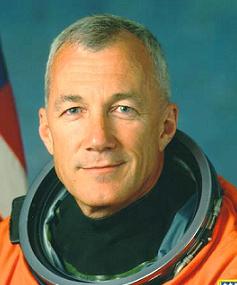- Terrence W. Wilcutt
Infobox Astronaut
name =Terrence W. Wilcutt

type =NASA Astronaut
status =Active
nationality =American
date_birth =birth date and age|1949|10|31
date_death =
place_birth =Russellville, Kentucky
place_death =
occupation =Test pilot
rank =Colonel , USMC
selection =1990 NASA Group
time =42d 00h 05m
mission =STS-68 ,STS-79 ,STS-89 ,STS-106
insignia =Terrence Wade Wilcutt (born
31 October 1949 ) is anUnited States Marine Corps officer and aNASA astronaut. He is a veteran of fourspace shuttle missions. Wilcutt is currently the Deputy Director, Safety and Mission Assurance,Johnson Space Center .Personal
Raised in
Louisville, Kentucky , Wilcutt earned a degree in mathematics fromWestern Kentucky University where he was a member of Lambda Chi Alpha fraternity. He then taught high school math for two years before entering theUnited States Marine Corps . He trained as a pilot and flew theF/A-18 before being assigned to theNaval Aircraft Test Center , where he worked on classified aircraft programs.NASA career
Wilcutt was selected as an astronaut candidate in 1990; he piloted missions
STS-68 (1994 ) andSTS-79 (1996 ). Wilcutt commanded missionSTS-89 (1998 ) to theMir space station andSTS-106 (2000 ) to theInternational Space Station .paceflight experience
STS-68 Endeavour (September 30 to October 11, 1994) was part of NASA’s Mission to Planet Earth. STS-68, Space Radar Lab-2 (SRL-2), was the second flight of three advanced radars called SIR-C/X-SAR (Spaceborne Imaging Radar-C/X-Band Synthetic Aperture Radar), and a carbon-monoxide pollution sensor, MAPS (Measurement of Air Pollution from Satellites). SIR-C/X-SAR and MAPS operated together in Endeavour’s cargo bay to study Earth’s surface and atmosphere, creating radar images of Earth’s surface environment and mapping global production and transport of carbon monoxide pollution. Real-time crew observations of environmental conditions, along with over 14,000 photographs aided the science team in interpreting the SRL data. The SRL-2 mission was a highly successful test of technology intended for long-term environmental and geological monitoring of planet Earth. STS-68 launched from Kennedy Space Center, Florida, and landed at Edwards Air Force Base, California. Mission duration was 11 days, 5 hours, 46 minutes, traveling 4.7 million miles in 183 orbits of the Earth.
STS-79 Atlantis (September 16-26, 1996), the fourth in the joint American-Russian Shuttle-Mir series of missions, launched from and returned to land at Kennedy Space Center, Florida. STS-79 rendezvoused with the Russian MIR space station and ferried supplies, personnel, and scientific equipment to this base 240 miles above the Earth. The crew transferred over 3.5 tons of supplies to and from the Mir and exchanged U.S. astronauts on Mir for the first time - leaving John Blaha and bringing Shannon Lucid home after her record six months stay aboard Mir. Mission duration was 10 days, 3 hours, 18 minutes, traveling 3.9 million miles in 159 orbits of the Earth.
STS-89 (January 22-31, 1998), was the eighth Shuttle-Mir docking mission during which the crew transferred more than 9,000 pounds of scientific equipment, logistical hardware and water from Space Shuttle Endeavour to Mir. In the fifth and last exchange of a U.S. astronaut, STS-89 delivered Andy Thomas to Mir and returned with David Wolf. Mission duration was 8 days, 19 hours and 47 seconds, traveling 3.6 million miles in 138 orbits of the Earth.
STS-106 Atlantis (September 8-20, 2000) was a 12-day mission during which the crew successfully prepared the International Space Station for the arrival of the first permanent crew. The five astronauts and two cosmonauts delivered more than 6,600 pounds of supplies and installed batteries, power converters, life support, and
exercise equipment on the Space Station. Two crew members performed a space walk in order to connect power, data and communications cables to the newly arrived Zvezda Service Module and the Space Station. STS-106 orbited the Earth 185 times, and covered 4.9 million miles in 11 days, 19 hours, and 10 minutes.External links
* [http://www.jsc.nasa.gov/Bios/htmlbios/wilcutt.html NASA Biography]
* [http://www.spacefacts.de/bios/astronauts/english/wilcutt_terrence.htm Spacefacts biography of Terrence W. Wilcutt]
* [http://www.crossandcrescent.com/2006/09/astronaut-to-math-teacher/ Sidebar "Together in Space"]
Wikimedia Foundation. 2010.
